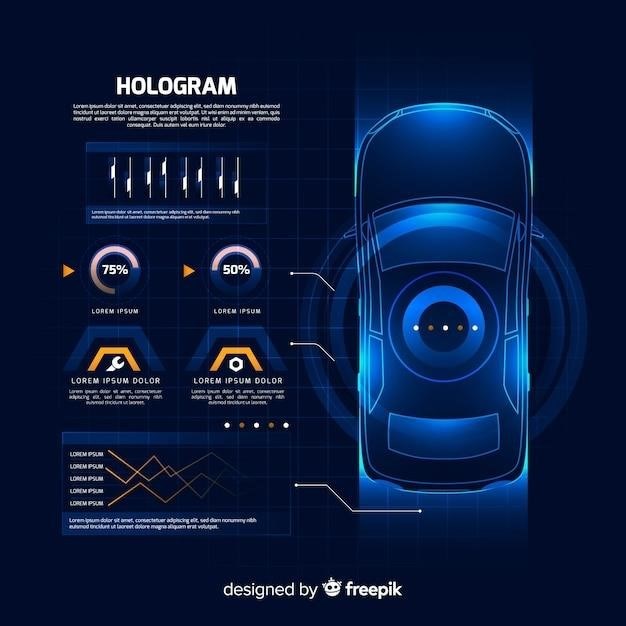Automotive Sensor Types
Automotive sensors are crucial for vehicle operation and safety․ They monitor various parameters‚ enabling advanced functionalities and diagnostics․ Categorization includes powertrain‚ chassis‚ and body sensors‚ each with numerous specific types․
Powertrain Sensors
Powertrain sensors are vital for engine control and performance monitoring․ Key examples include the mass airflow sensor (MAF)‚ measuring the amount of air entering the engine; the throttle position sensor (TPS)‚ indicating throttle valve position; and the crankshaft position sensor (CKP)‚ determining the crankshaft’s rotational position․ These sensors provide crucial data for engine management systems‚ optimizing fuel delivery and ignition timing for optimal efficiency and emissions control․ Other important powertrain sensors include the camshaft position sensor (CMP)‚ monitoring camshaft rotation; the oxygen sensor (O2)‚ measuring exhaust oxygen levels; and various pressure sensors‚ monitoring fuel rail pressure‚ intake manifold pressure‚ and more․ Precise measurements from these sensors are essential for smooth engine operation and preventing malfunctions․
Chassis Sensors
Chassis sensors play a critical role in vehicle stability‚ control‚ and safety․ Wheel speed sensors‚ crucial for anti-lock braking systems (ABS) and traction control‚ precisely monitor wheel rotation speed․ These sensors are essential for preventing wheel lockup during braking and maintaining traction on slippery surfaces․ Steering angle sensors measure the angle of the steering wheel‚ providing input for electronic stability control (ESC) and other driver assistance systems․ Acceleration sensors‚ measuring vehicle acceleration forces‚ contribute to the functionality of ESC and airbags․ Suspension sensors‚ although less common in standard vehicles‚ monitor suspension system parameters‚ contributing to advanced suspension control systems in high-end vehicles․ These chassis sensors work in concert to ensure safe and stable vehicle handling in various conditions․
Body Sensors
Body sensors enhance comfort‚ convenience‚ and security features within the vehicle; Occupancy sensors detect the presence and sometimes even the position of passengers‚ influencing airbag deployment and seatbelt reminders․ Rain sensors automatically activate windshield wipers based on detected rainfall intensity‚ improving driver visibility․ Light sensors adjust headlight intensity based on ambient light conditions‚ enhancing safety and visibility․ These sensors contribute to automatic climate control systems‚ adjusting temperature and ventilation according to passenger preferences and environmental factors․ Additionally‚ proximity sensors enable features like keyless entry and automatic door unlocking‚ improving user experience․ These sensors are crucial for modern vehicle functionality‚ enhancing both driver and passenger comfort and safety․

Sensor Applications in Vehicles
Automotive sensors play vital roles in safety‚ engine management‚ and comfort features․ They provide real-time data for improved vehicle performance and driver experience․
Safety Systems
Modern vehicles rely heavily on sensors for enhanced safety․ Anti-lock braking systems (ABS) utilize wheel speed sensors to prevent wheel lockup during braking‚ maintaining steering control․ Electronic stability control (ESC) employs various sensors‚ including yaw rate and lateral acceleration sensors‚ to detect and correct vehicle instability․ Airbag deployment systems use impact sensors to detect collisions and trigger airbag inflation‚ minimizing injuries to occupants․ Advanced driver-assistance systems (ADAS) such as adaptive cruise control and lane departure warning leverage radar‚ lidar‚ and camera sensors to monitor the vehicle’s surroundings‚ providing alerts and automatic interventions to prevent accidents; These sensor-based safety systems significantly improve road safety and reduce the severity of collisions․
Engine Management
Precise engine control relies heavily on a network of sensors providing real-time data․ The mass airflow sensor (MAF) measures the amount of air entering the engine‚ crucial for fuel injection calculations․ The crankshaft position sensor (CKP) monitors engine speed and piston position‚ synchronizing ignition timing and fuel delivery․ The throttle position sensor (TPS) detects the throttle plate’s position‚ informing the engine control unit (ECU) of the driver’s demand for power․ Oxygen sensors (O2 sensors) measure the oxygen content in the exhaust gases‚ allowing the ECU to adjust the air-fuel mixture for optimal combustion and emissions control․ Other sensors‚ such as coolant temperature sensors and intake air temperature sensors‚ provide data for precise engine management‚ optimizing performance and fuel efficiency while minimizing emissions․
Comfort and Convenience Features
Modern vehicles utilize numerous sensors to enhance driver and passenger comfort and convenience․ Rain sensors automatically activate windshield wipers based on precipitation levels‚ improving visibility and safety․ Light sensors control the headlights‚ switching them on or off depending on ambient light conditions․ Parking sensors use ultrasonic sensors to detect obstacles during parking maneuvers‚ providing audible warnings to prevent collisions․ Tire pressure monitoring systems (TPMS) employ sensors within the tires to monitor tire pressure‚ alerting the driver to low pressure which can compromise safety and fuel efficiency․ Climate control systems use temperature sensors to maintain the desired cabin temperature‚ automatically adjusting heating or cooling as needed for optimal passenger comfort․ These features significantly enhance the driving experience․

Key Sensor Technologies
Microelectromechanical systems (MEMS) sensors dominate the automotive market due to their small size‚ low cost‚ and high performance․ Other technologies‚ such as optical and magnetic sensors‚ also play significant roles․
MEMS Sensors
Microelectromechanical systems (MEMS) sensors have revolutionized the automotive industry‚ becoming ubiquitous components in modern vehicles․ Their miniature size‚ low cost‚ and high integration capabilities make them ideal for a wide range of applications․ MEMS technology enables the creation of highly sensitive and reliable sensors for various physical parameters‚ including acceleration‚ pressure‚ and angular rate․ These sensors are essential for safety systems like airbags and electronic stability control (ESC)‚ as well as for engine management and comfort features․ The widespread adoption of MEMS sensors is driven by their ability to provide accurate‚ real-time data crucial for optimizing vehicle performance and enhancing driver safety․ Moreover‚ advancements in MEMS technology continuously improve sensor performance‚ leading to smaller‚ more energy-efficient‚ and even more accurate devices․ This ongoing innovation is a key driver for the continued growth of the automotive sensor market‚ with MEMS sensors at its forefront․ The miniaturization achieved through MEMS technology allows for seamless integration into vehicles without compromising performance or efficiency․ This trend is projected to further intensify as autonomous driving and advanced driver-assistance systems (ADAS) become more prevalent․
Other Sensor Technologies
Beyond MEMS‚ a diverse array of sensor technologies contribute significantly to the functionality of modern vehicles․ These include optical sensors‚ which utilize light to measure various parameters like speed and distance; magnetic sensors‚ crucial for detecting wheel speed and engine position; and ultrasonic sensors‚ employed in parking assistance systems and adaptive cruise control․ Capacitive sensors play a vital role in measuring fuel level and various other parameters‚ while resistive sensors are frequently used in position sensing applications․ Furthermore‚ chemical sensors‚ such as those used in detecting exhaust gas composition‚ are essential for emissions control․ The selection of sensor technology depends on factors like required accuracy‚ cost‚ size constraints‚ and the specific parameter being measured․ Ongoing research and development continually introduce new and improved sensor technologies to the automotive market‚ pushing the boundaries of vehicle performance and safety․ The integration of these diverse sensor types contributes to the increasing complexity and sophistication of modern automobiles‚ paving the way for enhanced driver assistance and autonomous driving capabilities․ Each technology contributes to a unique aspect of overall vehicle functionality‚ creating a complex yet efficient system․
